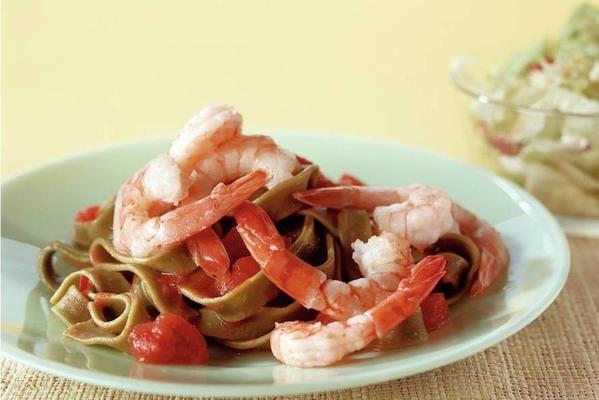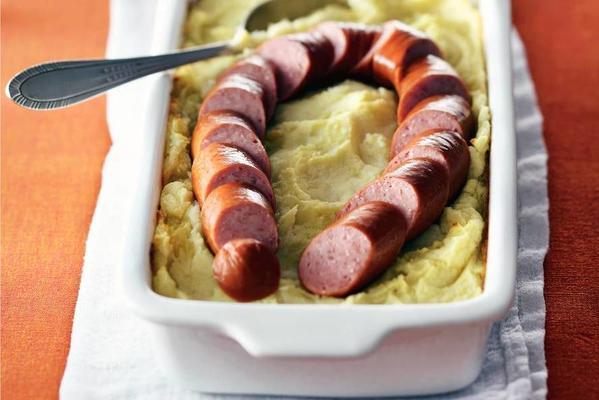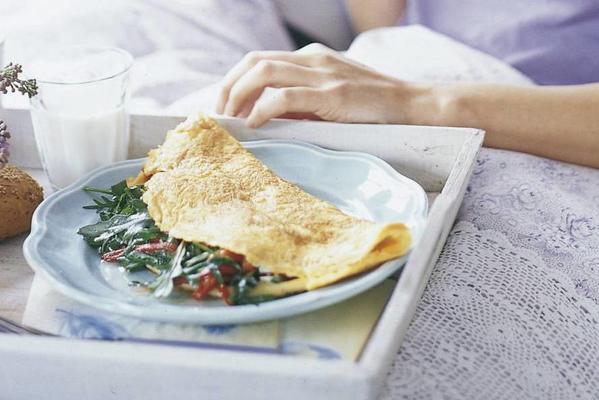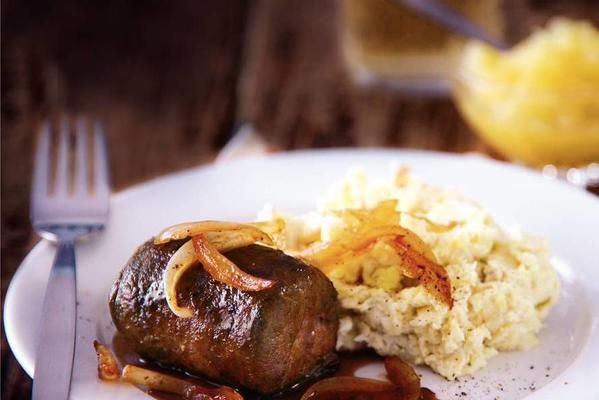High Protein Foods: The 8 Healthiest Protein Sources for Every Day
-
You want to build muscle, tone your body or simply stay healthy and fit. Getting enough protein is then essential. Although we really only need about 5% protein per day, it is better to consume at least 10 to 20% to avoid muscle loss. This is especially true if you are very active.
-
So if you eat 2000 kcal a day, you have to get 400 kcal of protein with 20% protein. 1 gram of protein contains 4 kcal, for a total of 100 grams of protein per day.
-
While meat, fish and other animal products are the most popular choice when you want to eat more protein, don't overlook the vegetable varieties. Eating too many animal products is simply not healthy. It is much better to choose a vegetarian option at least 2 to 3 times a week.
-
 11 minMain dishpeanut oil, tofu stir-fry cubes finely seasoned, stir fry sauce sweet and sour, thick noodles, carrot julienne, beetroot julienne, yellow bell pepper, watercress,rainbow salad with tofu
11 minMain dishpeanut oil, tofu stir-fry cubes finely seasoned, stir fry sauce sweet and sour, thick noodles, carrot julienne, beetroot julienne, yellow bell pepper, watercress,rainbow salad with tofu -
 45 minMain dishRed cabbage, mild olive oil, quinoa plus, forest outing, lemon, sesame oil, soy sauce less salt, Bio Today tahini white in pot, tap water,grilled red cabbage with quinoa salad
45 minMain dishRed cabbage, mild olive oil, quinoa plus, forest outing, lemon, sesame oil, soy sauce less salt, Bio Today tahini white in pot, tap water,grilled red cabbage with quinoa salad -
 30 minDessertBrie, Roquefort, port salut, gruyere, Camembert, walnut, garlic, thyme, honey, grape, baguette, Red onion, red grape, raisins, Red wine, Red wine vinegar, Brown sugar,generous cheese plate with onion marmalade
30 minDessertBrie, Roquefort, port salut, gruyere, Camembert, walnut, garlic, thyme, honey, grape, baguette, Red onion, red grape, raisins, Red wine, Red wine vinegar, Brown sugar,generous cheese plate with onion marmalade -
 30 minDessertFull Milk, whipped cream, macaroon, custard powder, vanilla sugar, sugar, protein, amaretto, almond liqueur, basic recipe cooking pears,macaroon pastry with casserole
30 minDessertFull Milk, whipped cream, macaroon, custard powder, vanilla sugar, sugar, protein, amaretto, almond liqueur, basic recipe cooking pears,macaroon pastry with casserole
-
In this article I want to share with you 8 excellent vegetable protein sources that not only serve as a powerful protein boost, but are also very tasty and varied!
-
Let's get started ...
1. Lentils
-
Lentils are one of the best sources of protein. They contain nearly 20 grams of protein per cup (cooked) and are also rich in complex carbohydrates and fiber. When you choose red lentils, you are also quickly done, because they are done within 40 minutes.
-
Lentils are one of the best sources of protein. They contain nearly 20 grams of protein per cup (cooked) and are also rich in complex carbohydrates and fiber. If you choose red lentils, you will also be ready quickly, because they are done within 40 minutes.
-
 5 minDrink without alcoholbananas, cool fresh apple-pear raspberry juice, Soy drink vanilla,soy fruit shake
5 minDrink without alcoholbananas, cool fresh apple-pear raspberry juice, Soy drink vanilla,soy fruit shake -
 20 minMain dishsauerkraut, sticking potato, liquid baking product, half-to-half minced, Spice meatballs, pineapple, olive oil, liquid baking product,gratin sauerkraut dish with minced meat
20 minMain dishsauerkraut, sticking potato, liquid baking product, half-to-half minced, Spice meatballs, pineapple, olive oil, liquid baking product,gratin sauerkraut dish with minced meat -
 40 minMain dishlemongrass, fresh ginger, Red peppers, onions, tomato cubes, fresh cod fillet, coriander, oil, ground turmeric (koenjit), coconut milk, salt,fish in creamy coconut sauce
40 minMain dishlemongrass, fresh ginger, Red peppers, onions, tomato cubes, fresh cod fillet, coriander, oil, ground turmeric (koenjit), coconut milk, salt,fish in creamy coconut sauce -
 15 minSide dishsweet potato, soft goat cheese, egg, spring / forest onion,stuffed sweet potato with egg
15 minSide dishsweet potato, soft goat cheese, egg, spring / forest onion,stuffed sweet potato with egg
-
Lentils fit perfectly in your salad, but can also be eaten as is with a wide variety of herbs and spices. They do well in Indian cuisine in particular.
-
If you would like something heartier, combine them with rice or make a tasty burger and eat together with a tomato sauce and pasta! You can make a quick meal with spiced lentils and whole grain tortillas.
2. Chia seeds
-
Chia seeds have long been used for their many health benefits. These little golden grains are packed with protein, fiber, vitamins and minerals. A very handy feature of these seeds is that they can also serve as a thickener. This is also due to the high fiber content of chia seeds. The soluble fiber almost provides a gel that you can then add to meals. Gluten-free baking dishes in particular can be bound well with this - even without egg!
-
Chia seeds have been used traditionally for their many health benefits. These little golden grains are packed with protein, fiber, vitamins and minerals. A very handy feature of these seeds is that they can also serve as a thickener. This is also due to the high fiber content of chia seeds. The soluble fiber almost provides a gel that you can then add to meals. Gluten-free baking dishes in particular can be bound well with this - even without egg!
-
 20 minMain dishTasty vine tomato, (olive oil, fresh basil, onion, garlic, Parmigiano Reggiano, zucchini spaghetti, pumpkin spaghetti, mini buffalo mozzarella,lukewarm pumpkin and zucchini spaghetti
20 minMain dishTasty vine tomato, (olive oil, fresh basil, onion, garlic, Parmigiano Reggiano, zucchini spaghetti, pumpkin spaghetti, mini buffalo mozzarella,lukewarm pumpkin and zucchini spaghetti -
 15 minSide dishtraditional olive oil, curry powder, wheat flour, coconut milk, sambal oelek, chicken broth tablet, water, fresh mango,curry sauce with mango
15 minSide dishtraditional olive oil, curry powder, wheat flour, coconut milk, sambal oelek, chicken broth tablet, water, fresh mango,curry sauce with mango -
 30 minMain dishtraditional olive oil, lean ground beef, frozen Mexican wok vegetables, salsa sauce mild, taco shell, grated young cheese, creme fraiche,Mexican vegetable in tacos
30 minMain dishtraditional olive oil, lean ground beef, frozen Mexican wok vegetables, salsa sauce mild, taco shell, grated young cheese, creme fraiche,Mexican vegetable in tacos -
 95 minMain dishmaize chicken, lemon, coarse sea salt, pepper, extra virgin olive oil, garlic, thyme, zucchini, tomatoes (small to), black olives without pit,provençal chicken with zucchini and tomatoes
95 minMain dishmaize chicken, lemon, coarse sea salt, pepper, extra virgin olive oil, garlic, thyme, zucchini, tomatoes (small to), black olives without pit,provençal chicken with zucchini and tomatoes
-
Of course you can also simply sprinkle chia seeds on your oatmeal. If you do this just before eating, the seeds will remain nice and crunchy. Did you know that you can also make a tasty pudding with chia seeds? To do this, soak 3 tablespoons of seeds with 3/4 cup of almond milk and a spoonful of honey (or stevia). Then let this stand for a few minutes and a little later you have a thick pudding. Here you can stir everything in, such as berries, cocoa powder, cinnamon, raisins, etc. A nice healthy breakfast!
-
Of course you can also simply sprinkle chia seeds on your oatmeal. If you do this just before eating, the seeds will remain nice and crunchy. Did you know that you can also make a tasty pudding with chia seeds? To do this, soak 3 tablespoons of seeds with 3/4 cup of almond milk and a spoonful of honey (or stevia). Then leave this for a few minutes and a little later you have a thick pudding. Here you can stir everything in, such as berries, cocoa powder, cinnamon, raisins, etc. A nice healthy breakfast!
3. Quinoa
-
One of my favorite ways to give my meals an extra protein boost is with quinoa. A strange name, because this plant originated in Peru. You pronounce it as kie-no-a. Did you know that quinoa is not a grain at all, but rather a seed? Unlike other seeds, quinoa is much lower in fat and tastes just like grains. It is therefore rich in complex carbohydrates and fiber.
-
One of my favorite ways to give my meals an extra protein boost is with quinoa. A strange name, because this plant originated in Peru. You pronounce it as kie-no-a. Did you know that quinoa is not a grain at all, but a seed? Unlike other seeds, quinoa is much lower in fat and tastes just like grains. It is therefore rich in complex carbohydrates and fiber.
-
What quinoa has in common with other seeds, and what makes it an excellent protein source, is that it contains a complete protein profile. This means that it contains all the amino acids that our body needs. Because of this complete protein, your body is also better able to promote cell regeneration. In short, choose quinoa more often!
-
You can use the seed just like grains such as wheat and rice. Moreover, it only has a short cooking time of about 15 minutes, so it is ready on the table! Quinoa with almond milk, honey and raisins also tastes great for breakfast in the morning - or for dessert!
4. Spirulina
-
Although meat and other animal products are usually considered to contain the highest quality protein, this is certainly not true in this case. Spirulina is a great protein source, which also has many other benefits to offer. Per 10 grams, Spirulina contains no less than 7 grams of proteins. Spirulina is a type of seaweed and is therefore a rich source of iodine and other essential minerals. Spirulina is available as a supplement consisting of a green powder.
-
Although the green color is less attractive (at least to eat!), The seaweed does not have a strong flavor. You can therefore perfectly process it in smoothies. Especially in a chocolate smoothie you don't taste any of it. And if you add two tablespoons of powder, you already have 8 grams of extra protein!
-
Of course you can also sprinkle it on your breakfast muesli or porridge if you wish, but be aware that it will have a stronger taste!
5. Nuts
-
Good health naturally requires more than just high protein consumption. Your body also needs vitamins, minerals and sufficient fiber, in addition to countless other substances. When you pack protein in foods rich in a variety of nutrients, your body can also use the protein better. Nuts are the perfect example of this. Just think of pistachios, walnuts, almonds, etc. All of these nuts are great sources of vitamin E, healthy fats, minerals and fiber. Each strain contains different nutrients that boost your health in their own way.
-
 25 minSmall dishflour, frozen puff pastry, egg, milk, walnut, mature cheese, paprika, dried Provençal herbs,puff pastry-sticks
25 minSmall dishflour, frozen puff pastry, egg, milk, walnut, mature cheese, paprika, dried Provençal herbs,puff pastry-sticks -
 20 minSide dishEggs, lettuce, parsley, olive oil (extra virgin), tarragon vinegar, salt and freshly ground pepper,lettuce with egg dressing
20 minSide dishEggs, lettuce, parsley, olive oil (extra virgin), tarragon vinegar, salt and freshly ground pepper,lettuce with egg dressing -
 15 minSmall dishbaking flour, peanut oil, flat leaf parsley,ar'nabit mi'li
15 minSmall dishbaking flour, peanut oil, flat leaf parsley,ar'nabit mi'li -
 15 minAppetizerScottish salmon fillet, butter or margarine, fresh dill, creme fraiche, dry white wine, arugula lettuce melange, pan tostado,baked salmon with white-wine sauce
15 minAppetizerScottish salmon fillet, butter or margarine, fresh dill, creme fraiche, dry white wine, arugula lettuce melange, pan tostado,baked salmon with white-wine sauce
-
My favorite nuts are walnuts. These contain a nice amount of omega-3 fats and are also nice and crunchy in the muesli or over the oatmeal. And if you fancy a rich, but healthy dessert, put two handfuls of walnuts in the food processor with a few dried dates and some cocoa powder. Mix everything until smooth and then divide into a mold. Press everything neatly and cool for half an hour. Then cut the slice into pieces and you have deliciously healthy, raw brownies!
6. Seeds
-
Nuts are always mentioned in a breath with seeds. Yet these are two different plants. Just like nuts, seeds are also very rich in proteins, fats and fiber, but contain even more vitamins and minerals. Seeds are therefore real powerhouses. They taste milder than nuts and are therefore more versatile.
-
Seeds, such as chia seeds, flax seeds, sunflower seeds, sesame seeds, etc., are ideal as an extra crunch on salad, in oatmeal or even finely ground in homemade cookies. You can also easily make a paste. A handful of seeds contains between 7 and 10 grams of protein. A big boost!
-
 25 minMain dishbalsamic vinegar, garlic, steak, Spaghetti, traditional olive oil, fresh green olive tapenade, arugula, Parmigiano Reggiano,spaghetti with steak and arugula
25 minMain dishbalsamic vinegar, garlic, steak, Spaghetti, traditional olive oil, fresh green olive tapenade, arugula, Parmigiano Reggiano,spaghetti with steak and arugula -
 15 minAppetizerfennel bulb, arugula, red pointed pepper, black agnus carpaccio (a 100 grams), capers,black angus carpaccio with fennel
15 minAppetizerfennel bulb, arugula, red pointed pepper, black agnus carpaccio (a 100 grams), capers,black angus carpaccio with fennel -
 35 minMain dishsweet potatoes, salad onion, garlic, cooking dairy, grated cheese for vegetable gratin, almond shavings, peanut oil, breaded schnitzels, Broccoli,crispy schnitzel with sweet potato gratin and broccoli
35 minMain dishsweet potatoes, salad onion, garlic, cooking dairy, grated cheese for vegetable gratin, almond shavings, peanut oil, breaded schnitzels, Broccoli,crispy schnitzel with sweet potato gratin and broccoli -
 30 minMain disholive oil, onion, tomato, risotto rice, laurel leaf, thyme, saffron, turmeric, fish stock of 1 tablet, mixed seafood, mixed whitefish fillet, mussel, lemon,fish paella from the oven
30 minMain disholive oil, onion, tomato, risotto rice, laurel leaf, thyme, saffron, turmeric, fish stock of 1 tablet, mixed seafood, mixed whitefish fillet, mussel, lemon,fish paella from the oven
7. Beans
-
In a list of the best vegetable protein sources, beans should of course not be missed. Legumes contain enormous amounts of protein and fiber, making them ideal as a meal base, especially for those looking to lose weight. Both protein and fiber have been shown to have a hunger-suppressing effect. Beans also come in a variety of varieties, something for everyone!
-
The disadvantage of legumes is of course that they can cause flatulence in sensitive people. But this also decreases over time. If you are not used to eating a lot of beans, build it up slowly until you notice that your intestines are no longer heard after eating!
-
Beans are delicious just like that, with your favorite herbs, or on salads, in spaghetti or of course in a tortilla, as the Mexicans eat them. A cup of cooked beans contains no less than 15 grams of protein, a good amount. Combine them with quinoa for a mega protein-rich meal (ideal after the gym!)
8. Tofu
-
Although soy has been badly put in the spotlight recently, you actually have nothing to worry about. In fact, as long as you eat soy products in moderation (i.e. no more than 120 grams per day and not every day), it will actually bring you benefits. Research has shown time and again that soy, and in particular fermented soy, can significantly lower your risk of breast cancer.
-
Tofu is made from soy milk in the same way as cheese from cow's milk. The resulting knit is pressed, so that most of the water runs out. You also have different variations of tofu; for example, you have the regular variant that you can easily cut into slices or cubes and use in savory dishes. However, you also have silky smooth tofu. This variant is smooth and very soft. It is not pressed and is ideal as a healthy alternative to cream cheese in desserts and cheesecakes.
-
My favorite use for tofu is as a meat substitute in spaghetti sauce. Simply crumble the tofu in your tomato sauce and let it cook for a while. Because the product takes on the flavor of whatever you add to it, you can indulge yourself and add your own touch.
-
A portion of tofu contains no less than 20 grams of protein. A generous portion for a meal!
-
 15 minMain dishgreen tagliatelle, garlic, Red pepper, olive oil, tomato cubes, cocktail shrimp, mixed salad, vinaigrette,spicy tagliatelle with shrimps
15 minMain dishgreen tagliatelle, garlic, Red pepper, olive oil, tomato cubes, cocktail shrimp, mixed salad, vinaigrette,spicy tagliatelle with shrimps -
 50 minMain dishsomething crumbly potatoes, sauerkraut natural, tomato paste, sambal oelek, bacon, semi-skimmed milk, unsalted butter, Gelderse smoked sausage,Sauerkraut with smoked sausage
50 minMain dishsomething crumbly potatoes, sauerkraut natural, tomato paste, sambal oelek, bacon, semi-skimmed milk, unsalted butter, Gelderse smoked sausage,Sauerkraut with smoked sausage -
 20 minBreakfastrucola lettuce, bunch onion, roasted red peppers in pot, traditional olive oil, medium sized egg, fresh cream, grated mature cheese, butter,creamy cheese omelet with arugula
20 minBreakfastrucola lettuce, bunch onion, roasted red peppers in pot, traditional olive oil, medium sized egg, fresh cream, grated mature cheese, butter,creamy cheese omelet with arugula -
 25 minMain dishceleriac, floury potatoes, olive oil, beef finches, onion, Apple juice, gravy natural, dairy spread,beeffinch with sweet apple gravy
25 minMain dishceleriac, floury potatoes, olive oil, beef finches, onion, Apple juice, gravy natural, dairy spread,beeffinch with sweet apple gravy
Finally ...
-
With 8 different protein sources, you too have probably found something you like. Do not try to combine everything in one day, because you do not need that much protein at all! A good guideline is 20 grams of protein per meal. With the above foods, this shouldn't be a problem at all! And if you don't like something, just choose another variant. Beans, lentils and tofu can easily be replaced with each other.
-
By using at least one of the above products every day, you will immediately get a healthy portion of fiber. Very handy if you want to lose a few pounds!
-
What is your favorite source of protein? And do you have any favorite ways to prepare this? Let us know in the comments!
-
Hsph.harvard.edu/nutritionsource/what-should-you-eat/protein/
-
Nutritionstudies.org/animal-vs-plant-protein/